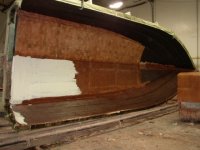journey on
New member
I just read a article in Latitude 38 about an "unsinkable" catamaran that sank. The assumption was that since the hull had 2 layers of fiberglass with balsa in between, this would provide enough flotation to keep a good part of the boat above water in case the hull was breached. That turned out to be false, as expected. Which leads to the topic of this post.
It's that statement about a double bottom hull on the Marinaut that I didn't understand. The topic grew so long and varied, that I'm starting this topic to find out how the Marinaut is built and what C-Nile ment.
I know that the hull of a C-dory 25 is made of 2 ea layers of fiberglass separated by balsa. The picture below shows the external layer, the end-grain balsa and then a final layer of fiberglass is added to provide the inside the hull. I assume the C-dory 22 is made the same.
That is done for structural reasons, not flotation. Just as an I-beam has flanges separated by a web, the separation of the 2 fiberglass layers add strength and stiffness, for the least weight. This structure, on a C-Dory, doesn't qualify as a double hull, but is a normal way of building a light, strong, cored structure.
I assume that a Marinaut hull is built along the same lines, for the same reasons. It may use plastic foam instead of balsa, but the design is the same. The Marinaut builders are knowledgeable people. Remember they designed my boat.
Now my question is: does the Marinaut indeed have a second hull, inside the external hull, with enough separation to provide positive buoyancy if the hull is flooded? If the double hull is just the 2 layers of fiberglass with foam separating it, I don't believe Marinaut would claim positive buoyancy for that.
The photo shows the C-Dory 25 outside hull with the balsa laid inside the hull. In fact, this is a shot of Journey On.
Boris

C-Nile":1lu0ohpr said:The other often overlooked feature of the Marinaut is that she really is a double bottom boat -- similar to what you see in large, modern cruises ships such that if the outer lower hull is breached, the sealed inner floor/hull should maintain water tight integrity. This to me is a great safety feature of the Marinaut 215.
Rich
It's that statement about a double bottom hull on the Marinaut that I didn't understand. The topic grew so long and varied, that I'm starting this topic to find out how the Marinaut is built and what C-Nile ment.
I know that the hull of a C-dory 25 is made of 2 ea layers of fiberglass separated by balsa. The picture below shows the external layer, the end-grain balsa and then a final layer of fiberglass is added to provide the inside the hull. I assume the C-dory 22 is made the same.
That is done for structural reasons, not flotation. Just as an I-beam has flanges separated by a web, the separation of the 2 fiberglass layers add strength and stiffness, for the least weight. This structure, on a C-Dory, doesn't qualify as a double hull, but is a normal way of building a light, strong, cored structure.
I assume that a Marinaut hull is built along the same lines, for the same reasons. It may use plastic foam instead of balsa, but the design is the same. The Marinaut builders are knowledgeable people. Remember they designed my boat.
Now my question is: does the Marinaut indeed have a second hull, inside the external hull, with enough separation to provide positive buoyancy if the hull is flooded? If the double hull is just the 2 layers of fiberglass with foam separating it, I don't believe Marinaut would claim positive buoyancy for that.
The photo shows the C-Dory 25 outside hull with the balsa laid inside the hull. In fact, this is a shot of Journey On.
Boris


